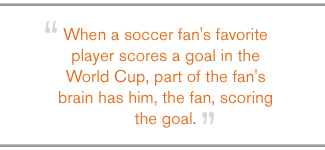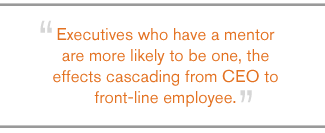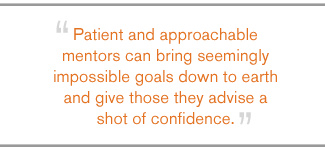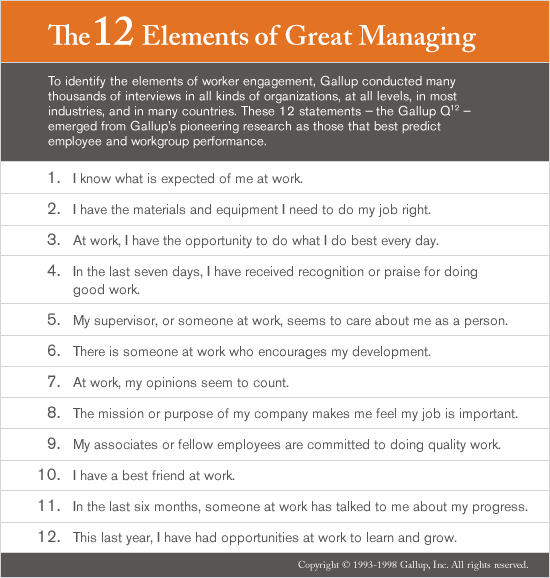One of the most powerful discoveries about how humans understand the world around them came about by accident. In the early 1990s, a group of researchers led by Dr. Giacomo Rizzolatti, a neuroscientist at the University of Parma in Italy, placed small electrodes in the brains of monkeys near the regions of the brain responsible for planning and carrying out movements. If the monkey picked up something, an electronic monitor that was connected to the wires in the animal's brain would sound -- "brrrrrip, brrrrrip, brrrrrip" -- to register the firing of those neurons.
 |
Then something happened -- something so unusual that the researchers thought it had to be a mistake. If the monkey saw one of the scientists doing something -- eating an ice cream cone, picking up a peanut or raisin, grabbing a banana -- the monitor registered the firing of brain cells as if the monkey had done it, when all the animal did was watch.
"It took us several years to believe what we were seeing," Rizzolatti told The New York Times. The structure behind the phenomenon was discovered to be what they called "mirror neurons," cells scattered throughout key regions of the brain that mimic everything the monkey sees another do.
Subsequent research found a far more complicated set of mirror neurons in people. This "human see; human do" circuitry is believed to be why a yawn can be contagious, why even a newborn will stick out her tongue if she sees someone else do it, and why American boys sometimes mimic the idiosyncrasies of their favorite baseball players at bat. "It explains much about how we learn to smile, talk, walk, dance, or play tennis," said a 2006 cover article in Scientific American Mind magazine. "At a deeper level, it suggests a biological dynamic for our understanding of others, the complex exchange of ideas we call culture, and psychosocial dysfunctions ranging from lack of empathy to autism."
The discovery of mirror neurons, as one researcher said, "completely changes the way we think about how the brain works." "Mirror neurons will do for psychology what DNA did for biology," said another. The implication is that that humans don't just passively observe other people in action, but in their minds, "do" whatever they see. When a soccer fan's favorite player scores a goal in the World Cup, part of the fan's brain has him, the fan, scoring the goal. The phenomenon helps to explain the power of television and movies to put viewers themselves into the action.
Though the discovery of mirror neurons was recent, the relationships they drive are an ancient idea. The word "mentor" is derived from the character Mentor in Homer's epic poem, The Odyssey. Mentor was given responsibility to counsel Odysseus' son Telemachus during his father's absence.
The concept perpetually reemerges in forms such as the relationships between master craftsman and apprentice, doctoral candidate and thesis supervisor, or resident physician and intern. Musicians learn by watching better musicians. Surgical students look over the shoulders of experienced surgeons. There is something about working closely with someone who supervises the less experienced person's progress that cannot be accomplished as well in any other way.
Most important for business, the ancient idea and the scientific discoveries demonstrate that if a company wants its employees to quickly assimilate "best practices," there is no faster conduit to a protégé's brain than watching a good role model in action. From this fact stems the Sixth Element of Great Managing, measured by the statement "There is someone at work who encourages my development."
A conduit to other elements of managing
While all of the 12 Elements require personal manager-to-employee or peer-to-peer interaction, the Sixth demands a higher degree of personal investment by the counselor in the education of his charge. For this reason -- and the power of mirror neurons when one person serves as mentor for another -- the Sixth is also a conduit to the other elements of managing.
It is difficult to get traction on any of the other elements without the Sixth. Consider the fairly large group -- on average, 4 in 10 -- who feel that neither their manager nor anyone else is looking out for their development. A mere 1% of those who have no mentor are able to achieve real engagement with their employer through the strength of the other 11 elements.
Conversely, two-thirds of employees who report having someone at work who encourages their development are classified as "engaged," while one-third are "not engaged," and less than 1% are "actively disengaged." These statistics indicate that regardless of whether a company's Web site or personnel department promises it, having a mentor is fundamental -- part of the unwritten social contract workers anticipate when they are hired. (See "At Work, Feeling Good Matters" in the "See Also" area on this page.)
Unfortunately, in their eagerness to force the issue universally, many companies create formal "mentoring" programs that try to assign the two people to each other or impose connections that, to be effective, must form naturally. As one Internet commentator complained, "What has been historically an informal, unofficial, voluntary, mutually agreeable, and self-selected interaction between two people has become a program -- an institutionalized stratagem for trying to force what probably can only come about naturally -- and a staple, if not a commodity, in the bag of tricks toted from client to client by many a consultant."
 |
A worker's manager is usually first in line to fulfill this role, but she is not alone. Doctors are often managed by administrators who are not physicians, but look for advice to the chief of surgery or to an approachable, more experienced doctor. Junior reporters may have their writing honed by editors, but they learn how to track down stories by following more senior reporters. Musicians follow the conductor, but they learn a substantial amount from those who play the same instrument.
Business writer Don Cohen once noticed that a few of the familiar brown United Parcel Service delivery trucks were always parked around 2:00 p.m. near a park in Massachusetts he often passed. The drivers sat on the nearby benches eating their lunch and talking. Curious, Cohen finally stopped one day to ask if this was just a way to avoid eating alone.
"Yes, they got together to have some company at lunch, but, 'We talk about everything and anything,' including a lot about work," wrote Cohen. "Drivers who had worked in town longest could tell newer drivers how to find unmarked streets and addresses and when particular customers were likely to be available to sign for a delivery. The veterans shared other special knowledge too: which customers wanted packages left in the garage or around the side of a house; when school let out and there were kids to watch for on the street and buses slowing traffic."
The drivers also told the author that they frequently exchanged packages to even out the workload, to help someone get home early, or to correct a mistake at the sorting center. Such gatherings may seem like a small thing, but given that much of exceptional performance is in the details and the importance of emulation to human learning, they can be some of the most important venues for creating a results-driven culture.
Little guidance for longstanding employees
Despite its importance at any point in a career, the frequency of Sixth Element connections steadily declines with age and tenure in the organization. More than half of employees aged 18 to 24 and of those less than six months into a new job indicate that someone at work encourages their development. But the percentage slips to just 1 in 4 for workers over 55 years of age, and to 1 in 5 for workers with 10 or more years at a particular company. Nothing in the data indicates that having a mentor is any less important for senior managers or employees than for newcomers, yet it appears many companies do not look after the guidance of their longstanding, loyal employees as well as they do those who just arrived.
Consistent with the biological imitation circuitry, the Sixth Element also has the strongest connection through levels of a company. Executives who have a mentor are more likely to be one, the effects cascading from CEO to front-line employee. The Sixth Element is the most sensitive among the 12 to this phenomenon of "manager see; manager do." A supervisor who is himself engaged feels a general reciprocal desire toward his employer and a specific interest in seeing new talent contribute to the company's success.
The guidance of a newer, younger employee by a manager is the stereotypical example because it most closely approximates the relationship of Mentor and Telemachus. But in its broadest usage, as captured by the Sixth Element, a mentor is anyone who, in the eyes of the employee, ensures she successfully navigates the course. The important aspect is not which of many terms this protector goes by -- friend, coach, advisor, sponsor, counselor, or supporter -- but whether the employee feels she is not abandoned inside the business.
As one grateful employee said of her guide in a Gallup interview: "She has seen things in me that I couldn't quite see in myself, has encouraged me to excel, has invited me to be promoted, has supported me and buoyed me up in a time when I was thinking, 'Gosh, won't I drown doing this? Are you sure I can?' And she told me, 'You might founder a little, but you won't sink. We won't let you.'"
Similar results using quantitative methods have been achieved dozens of times in assorted settings. For example, first-year MBA students assisted by second-year students who were assigned to help them navigate the program said the guidance helped them fit in at the graduate school, and that the more help they received from the more experienced students, the more it reduced their stress. Repeated failures of training manuals or computerized "knowledge management" systems have demonstrated that information, from hard facts to the most unofficial but helpful advice, travels much more effectively through these kinds of very personal channels.
 |
"We experience work as a human, social activity that engages the same social needs and responses as the other parts of our lives: the need for connection and cooperation, support and trust, a sense of belonging, fairness and recognition," wrote Cohen and coauthor Laurence Prusak. "But analysts still often see organizations as machines (for producing goods, services, or knowledge) or as an assemblage of self-focused individuals -- free agents or 'companies of one' -- who somehow manage to coordinate their individual aims long enough to accomplish a task."
Benefits to young managers
In the early 1980s, Boston University Professor Kathy E. Kram interviewed young managers at a public utility in the northeastern United States about their careers. Her key question: "Is there anyone among those that you have mentioned today that you feel has taken a personal interest in you and your development?" In follow-up interviews, she asked these managers about their sponsors.
From those interviews, the professor identified a number of benefits the young managers received. "Through career functions, including sponsorship, coaching, protection, exposure and visibility, and challenging work assignments, a young manager is assisted in learning the ropes of organizational life and in preparing for advancement opportunities," she wrote. Equally important, the protégés received "psychosocial" support -- a role model, a feeling of acceptance and confirmation they were doing well, counseling, and friendship.
People need role models whose accomplishments seem within reach. Patient and approachable mentors can bring seemingly impossible goals down to earth and give those they advise a shot of confidence.
Many highly accomplished people can recall a time early in their careers when such a shot in the arm made all the difference. "In fact," wrote "Dilbert" cartoonist and business cynic Scott Adams, "the most influential people in my life are probably not even aware of the things they've taught me."
Adams described how he suffered one rejection after another before Sarah Gillespie, an editor at United Media, called to offer him a contract. "At first, I didn't believe her. I asked if I'd have to change my style, get a partner -- or learn how to draw. But she believed that I was already good enough to be a nationally syndicated cartoonist," he wrote. "Her confidence in me completely changed my frame of reference: It altered how I thought about my own abilities. This may sound bizarre, but from the minute I got off the phone with her, I could draw better. You can see a marked improvement in the quality of the cartoons I drew after that conversation."
The benefits of being a protégé are clear, and they are sometimes emphasized so much that they overshadow the benefits of being a mentor. However, the fulfillment of encouraging another's development comes through in several of Kram's interviews. "I can tell you that the biggest satisfaction that I get is seeing someone that you have some faith in really go beyond where you expect and really see them get recognized," said one supervisor. "To see them do an excellent job and see them get recognized for it is probably the most gratifying thing, like seeing your son graduate from college, like seeing your mother get a degree when she's 45 years old -- it's that kind of pride that you take. You know you had faith in these people, you've helped them along, but you haven't told them what to do . . . It's like raising children . . . when you see those people get promoted and you're really pleased. And you say, 'You know, I've had something to do with that.'"
 |